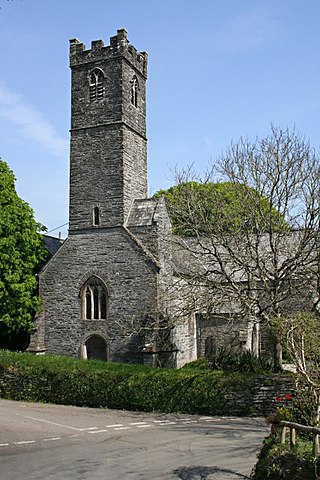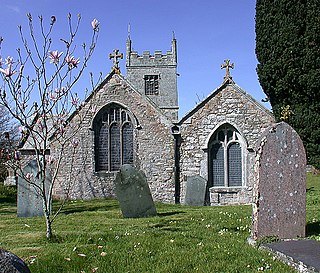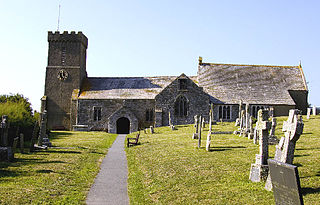
St Columb Major is a town and civil parish in Cornwall, England, United Kingdom. Often referred to locally as St Columb, it is approximately seven miles (11 km) southwest of Wadebridge and six miles (10 km) east of Newquay The designation Major distinguishes it from the nearby settlement and parish of St Columb Minor on the coast. An electoral ward simply named St Columb exists with a population at the 2011 census of 5,050. The town is named after the 6th-century AD Saint Columba of Cornwall, also known as Columb.

The Diocese of Truro is a Church of England diocese in the Province of Canterbury which covers Cornwall, the Isles of Scilly and a small part of Devon. The bishop's seat is at Truro Cathedral.
Charles Gordon Henderson was a historian and antiquarian of Cornwall.

The hundreds of Cornwall were administrative divisions or Shires (hundreds) into which Cornwall, the present day administrative county of England, in the United Kingdom, was divided between c. 925 and 1894, when they were replaced with local government districts.

St Mawgan or St Mawgan in Pydar is a village and civil parish in Cornwall, England, United Kingdom. The population of this parish at the 2011 census was 1,307. The village is situated four miles northeast of Newquay, and the parish also includes the hamlet of Mawgan Porth. The surviving manor house known as Lanherne House is an early 16th-century grade I listed building. The nearby Royal Air Force station, RAF St Mawgan, takes its name from the village and is next to Newquay Cornwall Airport. The River Menalhyl runs through St Mawgan village and the valley is known as The Vale of Lanherne. It was the subject of a poem by poet Henry Sewell Stokes.

Quethiock is a village and civil parish in Cornwall, England, United Kingdom, roughly five miles east of Liskeard. According to the 2001 census the parish had a population of 429, increasing to 443 at the 2011 census. The ancient parish church of St Hugh is one of the most notable in Cornwall. The placename derives from the Old Cornish cuidoc meaning wooded place. In 1871 the population was 661 and the area 4,351 acres (17.61 km2).

St Wenn is a civil parish and village in Cornwall, England, United Kingdom. The village is situated six miles (10 km) west of Bodmin and nine miles (14.5 km) east of Newquay. The parish population at the 2011 census was 369.

St Eval is a civil parish and hamlet in north Cornwall, England, United Kingdom. The hamlet is about four miles (6.5 km) southwest of Padstow. The parish population at the 2011 census was 960.

St Ervan is a rural civil parish and hamlet in Cornwall, England, United Kingdom. The hamlet is situated three miles (5 km) southwest of Padstow. St Ervan is named after St Erbyn, the original patron of the church, who is said to have been the father of St Selevan. Notable features in St Ervan are the Anglican church, the village hall and the Nonconformist cemetery. The parish population at the 2011 census was 521. In addition to the hamlet of St Ervan, also called Churchtown, the parish incorporates the hamlets of Penrose and Rumford.

Colan is a village and civil parish in mid-Cornwall, England, United Kingdom. It is situated approximately three miles (5 km) east of Newquay. The electoral ward is called Colan and Mawgan. The population of this ward at the 2011 census was 4,256 The hamlets of Bosoughan, Chapel, Gwills, Kestle Mill, Lane, Mountjoy, Quintrell Downs, Trebarber and Trencreek are in the parish. The Fir Hill, and Firhill Woods near Nanswhyden, contains the ruins of Fir Hill Manor. Colan Church dates to the thirteenth century.

St Gluvias is a settlement in Cornwall, England, United Kingdom. The village is now a suburb on the northern edge of Penryn which is two miles (3.2 km) northwest of Falmouth. Until 1 April 2021 there was civil parish was called St Gluvias which doesn't include the suburb but it was renamed to Ponsanooth.

Wendron is a village and civil parish in Cornwall, England, United Kingdom, 3 miles (5 km) to the north of Helston. The parish population at the 2011 census was 2,743. The electoral ward of Wendron had a 2011 population of 4,936.

St Carantoc's Church, Crantock is in the village of Crantock, Cornwall, England. Since 1951 the church has been designated as a Grade I listed building. It is an active Anglican parish church in the diocese of Truro, the archdeaconry of Cornwall and the deanery of Pydar. Its benefice is combined with that of St Cubert.

Sir John Arundell (1495–1561), of Trerice, Cornwall, nicknamed "Tilbury Jack", was a commander of the Royal Navy during the reigns of Kings Henry VIII and Edward VI and served twice as Sheriff of Cornwall.

Colan Church also known as St Colan Church is a 13th-century church in Colan, mid-Cornwall, UK. Dedicated to St Colanus, it became a Grade I listed building in 1967. The vicars of St Columb Minor have served the church since the middle of the 20th century.

Sir John Arundell (1474–1545) Knight Banneret, of Lanherne, St Mawgan-in-Pyder, Cornwall, was "the most important man in the county", being Receiver-General of the Duchy of Cornwall. His monumental brass in the church at St Columb Major in Cornwall was described by Dunkin (1882) as "perhaps the most elaborate and interesting brass to be found in Cornwall".
Lady Eleanor Arundell, was an English noblewoman, and the first wife of Sir John Arundell of Lanherne in Cornwall, "the most important man in the county", being Receiver-General of the Duchy of Cornwall. Their monumental brass in the church at St Columb Major in Cornwall was described by E. H. W. Dunkin (1882) as "perhaps the most elaborate and interesting brass to be found in Cornwall." Her father was Thomas Grey, 1st Marquess of Dorset. Eleanor was an ancestor of the later Barons Arundell of Wardour.

Sir John Arundell, called The Magnificent, of Lanherne in the parish of St Mawgan in Pydar in Cornwall, was an English knight who inherited large estates in the County of Cornwall. He was Sheriff of Cornwall and was one of Henry IV of England’s Kings Knights. In his will dated 1433, he bequeathed money for the preservation of the head of St Piran in the chapel at Perranzabuloe.

St Probus and St Grace's Church, Probus, is a Grade I listed parish church in the Church of England Diocese of Truro in Probus, Cornwall.
The following is a timeline of the history of St Columb Major, Cornwall, England, United Kingdom.
















